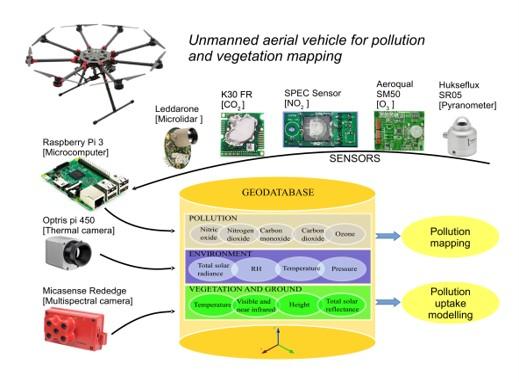Exhibitors 2018
- HOME AUTOMATION
- ROBOTICS
- YOUNG MAKERS (< 18)
- OPEN SOURCE
- 3D PRINTING
- DRONES
- EDUCATION
- FABRICATION
- HACKS
- NEW MANUFACTURING
- SCIENCE
- ENERGY & SUSTAINABILITY
- ART
- INTERNET OF THINGS
- MUSIC & SOUND
- RECYCLING & UPCYCLING
- KIDS & EDUCATION
- ARTISANS & NEW CRAFT
- CULTURAL HERITAGE
- GAMES
- WELLNESS & HEALTHCARE
- FASHION & WEARABLES
- FOOD & AGRICULTURE
- BIOLOGY
- 3D SCANNING
- AEROSPACE
- STEAM PUNK
- ARTIFICIAL INTELLIGENCE
- ARDUINO
- CROWDFUNDING
Il drone multirotore del CREA
Features of the DJI 1000 drone of the CREA FL that we use to evaluate the state of health of the vegetation in response to environmental stress:
The modification of the gimbal allows the simultaneous use of 3 sensors for proximal sensing:
- Optris pi 450 thermal chamber
- Leddarone laser distance meter
Micasense Rededge multispectral camera
On the upper part of the drone there is a box that houses a micrometereological station prototype:
- Raspberry pi 2 programmable data logger (linux);
- Various sensors: temperature and relative humidity (HS-2000V),
- atmospheric pressure (BMP180),
- Carbon dioxide (K-30 FR Fast Response 2Hz 1% CO2 Sensor),
- nitrogen monoxide (4-NO-250),
- nitrogen dioxide,
- carbon monoxide (4-NO-250),
- ozone (SM 50 OZU).
The SR05 pyranometer is mounted on the lower part. This, together with the ground surveys carried out at the same time, allows us to evaluate the energy balance between solar radiation and that reflected / transmitted by the objects present on the territory (eg vegetation).
The modification of the gimbal allows the simultaneous use of 3 sensors for proximal sensing:
- Optris pi 450 thermal chamber
- Leddarone laser distance meter
Micasense Rededge multispectral camera
On the upper part of the drone there is a box that houses a micrometereological station prototype:
- Raspberry pi 2 programmable data logger (linux);
- Various sensors: temperature and relative humidity (HS-2000V),
- atmospheric pressure (BMP180),
- Carbon dioxide (K-30 FR Fast Response 2Hz 1% CO2 Sensor),
- nitrogen monoxide (4-NO-250),
- nitrogen dioxide,
- carbon monoxide (4-NO-250),
- ozone (SM 50 OZU).
The SR05 pyranometer is mounted on the lower part. This, together with the ground surveys carried out at the same time, allows us to evaluate the energy balance between solar radiation and that reflected / transmitted by the objects present on the territory (eg vegetation).
Italy
Silvano Fares, Alessandro Alivernini
Dr Fares studies the exchange of greenhouse gases and atmospheric pollutants between plants and the atmosphere in response to abiotic stress such as high temperature and drought, and exposure to pollutants emitted by anthropogenic sources. He integrates laboratory and field observations at the leaf-level using plant enclosures connected to measuring sensors with observations at the whole tree level, e.g. use of "sap flow" sensors to measure the transport of water inside the stems and branches. He also masters micrometeorological techniques like Eddy Covariance to measure fluxes at the ecosystem level. Dr Fares’ skills also include use of PTRMS (proton transfer mass spectrometer) and GC-MS (Gas Chromatograph - Mass Spectrometer) to study exchanges of reactive volatile organic compounds between plants and the atmosphere. Trans-disciplinary expertise allow him to parameterize complex mechanistic canopy models composed of cutting edge algorithms to explain eco-physiological and atmospheric processes to quantify gas exchange between agro-forest ecosystems and the atmosphere.
Senior scientisit, Dr Fares is the National Coordinators of ICOS (Integrated Carbon Observation System) ecosystem sites and supervises a long-term monitoring site in a Holm Oak Forest inside the Presidential Estate of Castelporziano, thyrrenian coast of central Italy, recently EU ICOS site, where meteorological parameters are measured since 1997 and continuous flux measurement of CO2, water, methane, ozone, particles and nitrogen oxides are measured since 2010. He organizes international field campaigns where plant-atmosphere interactions are studied in a trans-disciplinary approach which includes ecophysiology, atmospheric chemistry and environmental modeling. He is internationally recognized as an expert in plant-atmosphere exchange of greenhouse gases and Volatile Organic Compounds.
Senior scientisit, Dr Fares is the National Coordinators of ICOS (Integrated Carbon Observation System) ecosystem sites and supervises a long-term monitoring site in a Holm Oak Forest inside the Presidential Estate of Castelporziano, thyrrenian coast of central Italy, recently EU ICOS site, where meteorological parameters are measured since 1997 and continuous flux measurement of CO2, water, methane, ozone, particles and nitrogen oxides are measured since 2010. He organizes international field campaigns where plant-atmosphere interactions are studied in a trans-disciplinary approach which includes ecophysiology, atmospheric chemistry and environmental modeling. He is internationally recognized as an expert in plant-atmosphere exchange of greenhouse gases and Volatile Organic Compounds.
E18 (pav. 4)




















































































